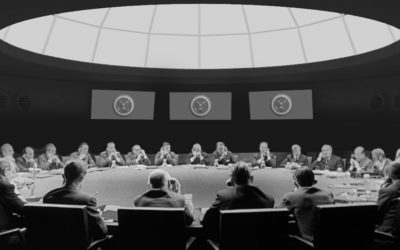To put it mildly now is a time for lions, not lambs.
As the nation and the world continue to wrestle with the beginning (this is just the beginning), of the Chinese coronavirus pandemic and the economic impact of shutting down the economy, now is a time for war-time leadership.
SitRep – A Discerning Look At The Current Pandemic Economy
1.This surge of supply combined with the decrease of demand, combined with a tanking economy means that the market is exponentially more competitive and price sensitive.
2. Virtually overnight, each and every one of your direct and indirect competitors were forced to digitize their business operations, distribute their workforce for remote work, and convey their messages via the web. This means increased advertising costs (we’re already seeing), and lower reach.
Before the Chinese coronavirus there was already a Fight For A.I.R. AND IT JUST GOT 100X HARDER.
By AIR, I mean, the individual person v. person competition for attention, influence and relevance. The Digital Age already exponentially increased everyone’s direct and indirect competition in 2 ways:
Globalization (providing access to businesses all over the world to even the smallest mom & pop or individual).
The emergence of the attention economy and resulting fragmentation and creation of The “Personal Brand” – Fragmentation of consumers, households, families & individuals by making them compete for attention, influence and relevance on social media. Grandma competes with the cute girls on Instagram for her grandson’s attention, just as the cafe competes with the shoe store.
These two things were already alive and well before the pandemic, and The pandemic just sent a tidal wave of laggards into the space.
War Time Leadership – 9 Bad Habits and Dead Weight Practices You Need to Fire From Your Business
In previous years, heck just 60 short days ago, the peace-time economy afforded many leaders luxuries that no longer exist. There were many soft cultural practices that added costs, hindered production, productivity, and smooth operations.
Many businesses were already in a SNAFU situation before the pandemic. Now is a time to step up your game 10x, not to thrive, but just to survive. You read that right. So at the very, very least. Now is a time to cut the BS, because you can’t afford it. Let’s go over what kind of dead weight we’re talking about removing.
Things leaders got away with will no longer work:
- Pretending to have a coherent brand and defined culture. You need crisp hard principles that can be clearly defined and that clearly support sustainable, high performance.
- Offering a dysfunctional, disconnected customer experience. You need to offer a clear, unified customer experience across all stages of the journey. This requires brand and cultural markers present in the omnichannel and each touchpoint.
- Lagging behind the market and the competition in terms of digitization. Be the leader who ensures that every remote employee has a MINIMUM of 2 monitors and a high-performance computer. That second monitor you may invest in, gives a 20% productivity boost, or according to a JPR study a 42% productivity boost (source). At the core, in terms of technology leadership, your war-time mantra has to be “global reach at a moment’s notice” . If your digital strategy can live up to that, you’re ahead of the curve.
- Lagging behind the market in terms of logistics, and shipping. Now is not a time to be slower than Amazon. That’s a high bar to clear, but regardless, that is the bar of customer expectation.
- Pretending to have a clear strategy. During war-time it’s harder to fake having a plan, because the impact and results come back faster than ever.
- Ignoring your strategic plans, and constantly winging it. You must think things through and bake in escape routes and contingencies in an ongoing basis. You must strain your vision to look to the horizon as well as the moment.
- Endlessly shopping for easy buttons, turnkey solutions, the delegation of anything and everything. By now you must know everyone sells to this urge, especially in times of crisis. Now is a time to dig into discerning reviews, find solutions that work, usually the less sexy ones that require work. The solutions more transparent about the inputs and resources, though less sexy, more complicated, if you can account for them, are more likely to be successful. There is also an added advantage here if you can avoid all the mousetraps and snake oil purchases that your competitors will make you have an added edge. This goes beyond procurement practices and to the mindset of the leader that has this habit to begin with.
- Pretending to care about your customers, stakeholders, and employees. (HINT: If you sent a “we care about you” email in the last 90 days, you probably fall into this category). Find a way, in your culture’s own native language to truly show you care. The public has 0 tolerance for PR and PC. You won’t notice their disdain for these messages until things go back to normal, but they will not forget how fake these messages felt.
- Vanilla B.S. Barely There marketing efforts. Since people can no longer meet face to face for the most part, Word Of Mouth marketing has taken a huge hit and is now pretty much web and phone driven. And to those who would argue, it’s been well studied, trust-building on the web is 34x more difficult than face to face interaction, even when we’re talking about video conferencing.
Won’t Zoom Meetings Save Us All?
Video Conferencing tools like Zoom, will help us maintain existing customers, they are not nearly as effective as face to face meetings were in terms of developing trust.
Who am I to say that?
I’ve worked with a distributed team for 17 years. We run an innovation lab and keep score of how we’ve courted business over various mediums, and there are countless studies and TED Talks on this phenomenon. The short version is the human brain, unconsciously perceives a video conference as an abstraction, like a cartoon, and is prone to mistrust, misrepresent or outright lie via video. Another hindrance to trust-building, to put it in the bluntest of terms, more shenanigans will ensue via video and phone because either party knows they can’t punch the other one in the throat if they misbehave.




0 Comments